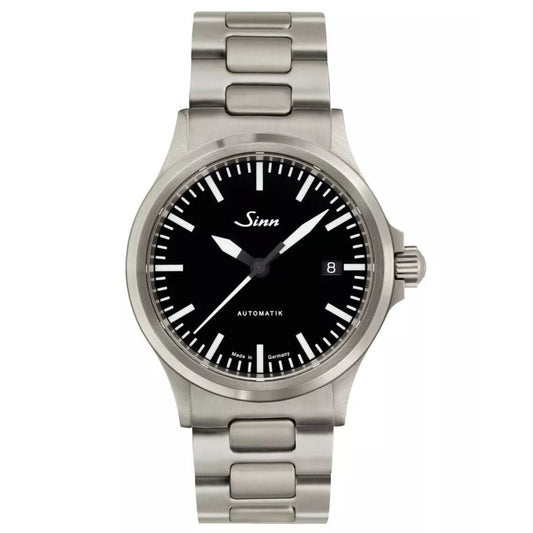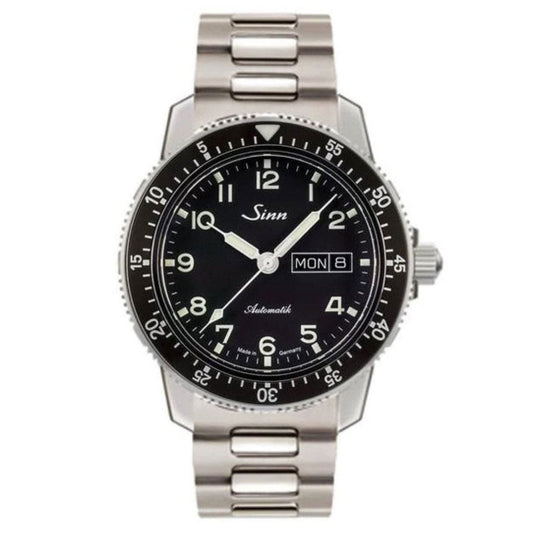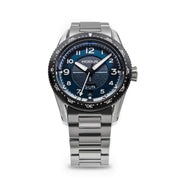Like so many wristwatches, the Pilots watch, as we know it today, originates in warfare.
Since the days of the first aircraft, which were a challenge to fly, it was widely accepted that fumbling for a pocket watch was far from ideal. Few cockpit displays had a reliable chronometer, and pocket watches of the era were not designed for purpose. In the early 20th Century, the idea of strapping a watch to your wrist was very much in its infancy, and it took the advent of Ariel combat in World War One for us to begin to see wristwatches in the sense that we understand them today.




What is the purpose of a Pilots watch?
The requirements for a pilot watch were different, although not vastly so, from a WW1 infantry watch, especially in the formative years. The dial would be preferably black, and the large indices and hands must stand out proudly. Maximum legibility was the principal objective, with accurate time keeping a close second. Easy watch manipulation was essential, and very soon, the earliest pilot watches had large textured crowns to allow adjustment with heavy insulated flying gloves.
Accuracy with a pilot's watch was paramount because as aircraft flew ever greater distances, navigation and fuel calculations became more relevant. With the aid of a decent wristwatch, pilots could now calculate speed, distance, and the time they had spent on a particular part of the journey, thus allowing accurate fuel estimations. It's basic mathematics: speed x time = distance. And a reliable watch helps in this process. From an operational perspective, an accurate watch and reliable navigational equipment also allowed the crew to find precise bombing locations and deliver their ordinance on target.


The Beobachtungsuhr
For this brief study, it is not unreasonable to say that the first genuine pilot watch was the instantly recognisable Laco FL 23883, from the 1930s, which is made today, all be it modernised but still based on watches made for German flight crews in World War Two.
 Laco Flieger-Original - Credit Laco
Laco Flieger-Original - Credit Laco
During the War, navigation for bombers was primarily a map and mechanical instrument skill, so the German Air Force created a requirement for observation watches (Beobachtungsuhr) under military specification reference FL 23883. These wristwatches were destined not for pilots but for navigators. To determine their exact position, the onboard navigator would use his large 55mm Laco wristwatch and the aircraft's octant (sextant) to determine a precise position. Given the basic flying conditions in 1940s military aircraft, instant legibility and precision were paramount. To guarantee this, Laco created both a Model A and Model B dial. Model A was a simple design with numbered hours, 1 to 11, with the 12 replaced by a triangle and two dots, ensuring high visibility, accurate zeroing, and easy watch orientation.
 Laco Flieger-Pro - Credit Laco
Laco Flieger-Pro - Credit Laco
The Model B dials displayed oversized minute numbers in increments of 5 in an outer track where you would traditionally expect to see the 1-12 markers. This unusual design was considered more relevant for navigation, so the hour track was relegated to a smaller inner sub-dial. Navigational orientation was achieved by using a bold arrow at the 12 mark.
It's worth mentioning that IWC also created an early pilot watch in the form of the 1936 model "Special Pilot's Watch" (Ref. IW436), and then a much better World War Two variant called The Big Pilot's Watch Calibre 52 TSC (Ref. IW431). Like the Laco, this was 55mm in diameter and built under similar design specifications for the Luftwaffe.
 Omega Dirty Dozen - Credit WatchGecko
Omega Dirty Dozen - Credit WatchGecko
Allied pilots from the UK or USA could not wear oversized pilot watches but instead opted for smaller very simple Watches based loosely on the American A-11 World War 2 issue watch or the British Dirty Dozen watch. RAF pilots or watches from brands such as Omega and Longines which were of a very simple design, some without even the subdial, which was synonymous with The Dirty Dozen. These Watches did not have the same level of aviation thought process as the German models.
The Chronograph
Yet no matter how much the Laco is the quintessential Pilot's watch to many of us, if you ask someone to describe a pilot's watch, more often than not, it will be a chronograph. Chronographs have far superseded the big, bold watches which spawned the genre. It is interesting that during World War 2 most pilots were issued with accurised, high lume, versions of standard infantry watches such as the Bulova variant of the American A-11, which was deployed with naval aviators and it was not until the end of the war pilot chronographs, recognisable to us today, started to appear.
So why would chronographs be of more value than a bespoke Pilot watch? Chronographs were designed for very accurate time measurement over more extended periods. Once these watches evolved, it is clear from what we have analysed earlier why they would be of so much use to our Pilot.
 Brellum Black Chronometer - Credit Brellum
Brellum Black Chronometer - Credit Brellum
A complication which is supported by all chronograph watches is a stopwatch, which works alongside and independently from the main time-keeping capability of the watch. The literal translation of chronograph is time writer. This refers to the process of marking elapsed time with a pen. Doing this within your watch made speed time fuel calculations infinitely easier.
For those unfamiliar with how chronograph watches work, they can measure time in seconds, minutes, hours like any watch but also in much smaller denominations such as tenths and hundredths of a second. They operate like a mechanical stopwatch with two buttons: one to start and stop the chronograph function and one to reset it. All controls on chronograph watches, whether used in the early days of Formula One or for a pilot, are generally located on the right side of the watch above and below the crown and are very easy to manipulate, even with gloves (or a space suit).
 Geckota Chronotimer Racing Chronograph Watch White Dial Classic Panda - Credit WatchGecko
Geckota Chronotimer Racing Chronograph Watch White Dial Classic Panda - Credit WatchGecko
Modern Pilot Watches
Now that we have reached chronographs Pilot watches haven't changed much in the last 70 years. We still make beautiful hand-wound and automatic chronograph models, which are today synonymous with being Pilot watches. It's interesting to take a look back in history and realise that the first pilot watches were nothing like these designs; however, now there is no question that a pilot's watch is a complex chronograph perhaps typified by models such as the Breitling Navitimer, Omega Speedmaster or archetypal IWC Pilot. These watches have well thought out complications, including tachometers and slide rules for remarkably complex calculations, giving pilots critical backup capability in the event of instrumentation failure.
 Breitling Navitimer - Credit WatchGecko
Breitling Navitimer - Credit WatchGecko
Many smaller brands are also making stunning Pilot watches, which bring a real sense of aviation heritage yet benefit from thoroughly modern design and the latest horological advances. Specifically, we admire brands like Brellum, who make the almost perfect 2023 Pilot GMT LE.2 Chronometer, or Sinn with their 356 Sa Pilot Watch Automatic Chronograph. Both of which are as fine an example as you can buy today.
If you ask if a modern pilot watch is invariably a chronograph, then the answer is yes. If you ask if a chronograph is always a Pilot watch, then the answer is not necessarily. Pilot Watches have a very distinctive style and design compared to a chronograph born from the racetrack. They are a beautiful addition to any collection because they are a relatively common design ethos which has evolved over the last 100 years into superbly legible and functional time pieces which have outstanding calibres delivering high accuracy and a design where legibility is nigh on perfect. If this short history of the pilot watch has whetted your appetite to own one, then here are a few suggestions.
 Sinn 356 Sa Pilot Watch Automatic Chronograph - £2850
Sinn 356 Sa Pilot Watch Automatic Chronograph - £2850
The Sinn 356 Pilot was inspired by the early Sinn 256 Pilot Chronograph. The chronograph dial has a clean, contemporary look and features 3 subdials, a date/day display and luminescent hands and indices.
On this 356 "Sa" version, the dial is housed under sapphire crystal and rests over a screw-fastened display caseback, providing up to 100 metres of low-pressure and water resistance. The Sinn 356 Pilot watch meets the waterproof requirements set out in standard DIN 8310.
The case measures at 38.5mm and is crafted from bead-blasted stainless-steel for impressive durability. The Sinn 356 Pilot uses a self-winding Sellita SW-500 movement and features 28,800 semi-oscillations per hour, a seconds stop function and an antimagnetic design as per DIN 8309.
 Sinn 104 St Sa A Pilots Watch - £1665
Sinn 104 St Sa A Pilots Watch - £1665
Non-chronograph and taking inspiration from older pilots watches, the Sinn 104 St Sa A is enhanced by vintage inspired touches that allow for optimum readability. The dial is clearly structured with date/day display, luminous hands and indices and a bidirectional captive pilot's bezel with minute ratcheting.
The 104 pilot watch uses a 41mm polished stainless-steel case that's waterproof and low-pressure resistant to 20 bar as per DIN 8310, housed beneath a sapphire crystal with double anti-reflective coating.
Sapphire crystal is also featured on the screw-fastened caseback, framing the self-winding Sellita SW220-1 movement. This reliable movement has antimagnetic properties, powering the Pilot watch at 28,800 semi-oscillations per hour and benefits from a seconds stop function.
Author Note: For this feature, we have assumed Pilot watches mean chronographs, as would be imagined when someone says a "pilot watch." However, there is an excellent argument that GMT watches, such as the Rolex GMT-Master, are bespoke pilot watches. The GMT-Master was designed for Pan-Am crews to show alternate time zones. However, we decided, from an editorial perspective, to contain this feature to classic Pilot Chronographs.
If you'd like to hear more about specific Pilot GMT watches, please let us know in the comments below.











